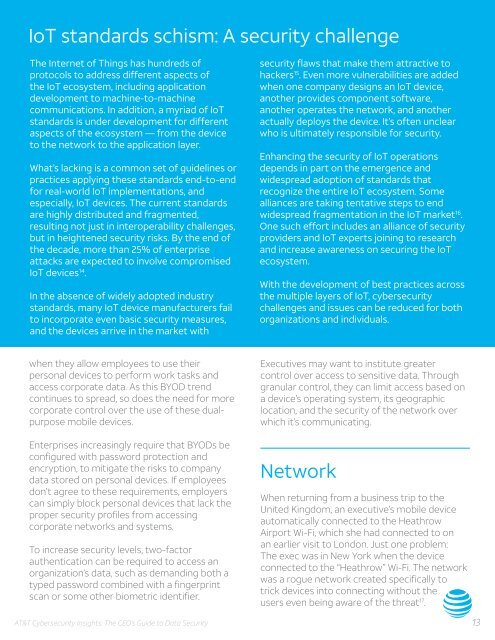The CEO’s Guide to Data Security
2mRmvHx
2mRmvHx
You also want an ePaper? Increase the reach of your titles
YUMPU automatically turns print PDFs into web optimized ePapers that Google loves.
IoT standards schism: A security challenge<br />
<strong>The</strong> Internet of Things has hundreds of<br />
pro<strong>to</strong>cols <strong>to</strong> address different aspects of<br />
the IoT ecosystem, including application<br />
development <strong>to</strong> machine-<strong>to</strong>-machine<br />
communications. In addition, a myriad of IoT<br />
standards is under development for different<br />
aspects of the ecosystem — from the device<br />
<strong>to</strong> the network <strong>to</strong> the application layer.<br />
What’s lacking is a common set of guidelines or<br />
practices applying these standards end-<strong>to</strong>-end<br />
for real-world IoT implementations, and<br />
especially, IoT devices. <strong>The</strong> current standards<br />
are highly distributed and fragmented,<br />
resulting not just in interoperability challenges,<br />
but in heightened security risks. By the end of<br />
the decade, more than 25% of enterprise<br />
attacks are expected <strong>to</strong> involve compromised<br />
IoT devices 14 .<br />
In the absence of widely adopted industry<br />
standards, many IoT device manufacturers fail<br />
<strong>to</strong> incorporate even basic security measures,<br />
and the devices arrive in the market with<br />
security flaws that make them attractive <strong>to</strong><br />
hackers 15 . Even more vulnerabilities are added<br />
when one company designs an IoT device,<br />
another provides component software,<br />
another operates the network, and another<br />
actually deploys the device. It’s often unclear<br />
who is ultimately responsible for security.<br />
Enhancing the security of IoT operations<br />
depends in part on the emergence and<br />
widespread adoption of standards that<br />
recognize the entire IoT ecosystem. Some<br />
alliances are taking tentative steps <strong>to</strong> end<br />
widespread fragmentation in the IoT market 16 .<br />
One such effort includes an alliance of security<br />
providers and IoT experts joining <strong>to</strong> research<br />
and increase awareness on securing the IoT<br />
ecosystem.<br />
With the development of best practices across<br />
the multiple layers of IoT, cybersecurity<br />
challenges and issues can be reduced for both<br />
organizations and individuals.<br />
when they allow employees <strong>to</strong> use their<br />
personal devices <strong>to</strong> perform work tasks and<br />
access corporate data. As this BYOD trend<br />
continues <strong>to</strong> spread, so does the need for more<br />
corporate control over the use of these dualpurpose<br />
mobile devices.<br />
Enterprises increasingly require that BYODs be<br />
configured with password protection and<br />
encryption, <strong>to</strong> mitigate the risks <strong>to</strong> company<br />
data s<strong>to</strong>red on personal devices. If employees<br />
don’t agree <strong>to</strong> these requirements, employers<br />
can simply block personal devices that lack the<br />
proper security profiles from accessing<br />
corporate networks and systems.<br />
To increase security levels, two-fac<strong>to</strong>r<br />
authentication can be required <strong>to</strong> access an<br />
organization’s data, such as demanding both a<br />
typed password combined with a fingerprint<br />
scan or some other biometric identifier.<br />
Executives may want <strong>to</strong> institute greater<br />
control over access <strong>to</strong> sensitive data. Through<br />
granular control, they can limit access based on<br />
a device’s operating system, its geographic<br />
location, and the security of the network over<br />
which it’s communicating.<br />
Network<br />
When returning from a business trip <strong>to</strong> the<br />
United Kingdom, an executive’s mobile device<br />
au<strong>to</strong>matically connected <strong>to</strong> the Heathrow<br />
Airport Wi-Fi, which she had connected <strong>to</strong> on<br />
an earlier visit <strong>to</strong> London. Just one problem:<br />
<strong>The</strong> exec was in New York when the device<br />
connected <strong>to</strong> the “Heathrow” Wi-Fi. <strong>The</strong> network<br />
was a rogue network created specifically <strong>to</strong><br />
trick devices in<strong>to</strong> connecting without the<br />
users even being aware of the threat 17 .<br />
AT&T Cybersecurity Insights: <strong>The</strong> <strong>CEO’s</strong> <strong>Guide</strong> <strong>to</strong> <strong>Data</strong> <strong>Security</strong> 13



